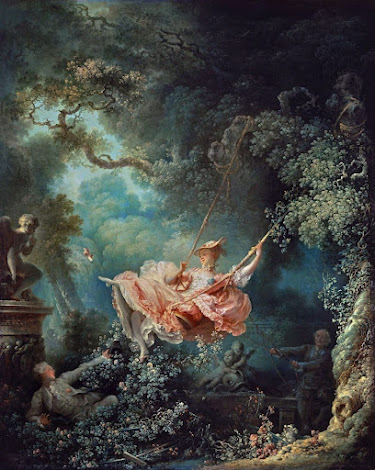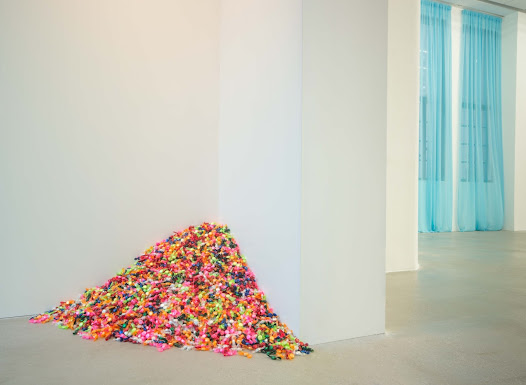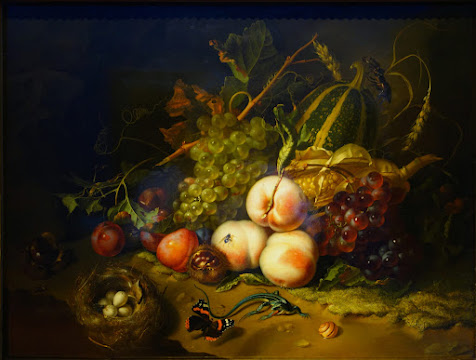Classic Blog
The painting shown below is The Swing by Jean-Honoré Fragonard. This painting was done in 1767 using oil on canvas. It measures 81 x 64.2 cm.
This painting above is from the Rococo period. In it, we see a well dressed woman on a swing, front and center. Behind her a man pushes the swing. Below, in the bushes in front of the woman, is a man looking up at her as she lifts her legs in order to show him under her skirt. As you can tell, the painting shows well dressed, wealthy people in a very playful, sexualized manner. Although there is no skin bared in the image, the action being portrayed is very lustful and cheeky. In this image, our focus is pinpointed directly on the woman in the swing. The bright pink and white of her dress stands out amongst the blue and greens of the forest surrounding her. Her dress looks very fluid with the movement of the swing. The shape and color of the dress remind me of a rose, which could be associated with love. Below the swing, there is two baby cupids wrapped around each other. This also represents love.
The painting shown below is The Triumph of Venus by François Boucher. It was finished in 1740 using oil on canvas. It measures 130x162 cm.
Above, we see another painting finished during the Rococo period. Unlike The Swing, there is no explicitly flirtatious action being portrayed here. However, in turn, every figure we see is nude. This painting shows Venus sitting at the highest point, surrounded by many nude figures in and above the water. Overhead, are many cupids, as well as laying near the water below Venus. These cupids represent love as well as the other figures shown in the painting. The figures are posed very sensually against the water and fish. We see nearly all of the figures resting upon or touching one another. The use of lighting on and around Venus makes her stand out, as well as her position at the very top.
Both paintings shown above are from the Rococo era. This period is known for the playful nature of aristocratic luxuries and past times. In this style of art there is a lot of portrayal of outdoor activities, as well as erotic scenes and love. Rococo was focused on idealism rather than realism, and much of the work involved luxurious clothing and jewelry, as well as fun past times of aristocrats. Rococo strayed so far from artwork before it because it bent so many rules. There was no religious or political theme that it needed to adhere too. The work was light and fun and it was often commissioned for pleasure palaces. In addition, the brushwork was quite literally light and airy as well during this time period. The colors tended to be pastels. Because of the very specific population these paintings were made for/about, the style did not stick around for long. The Rococo style was considered immoral and superficial. The work was deemed pretentious due to the subject matter. This was especially hammered in as the the rising of the revolution in France became greater. In this wake, Neoclassicism was born. This art style was focused on patriotism.
The painting shown above is Oath of the Horatii by Jacques-Louis David. This was painted in 1784 with oil on canvas. It measures 3.3 x 4.25 m.
The painting shown above is an example of the Neoclassic movement that stemmed from the fervor of the French Revolution. There was more emphasis on linear design and classical subject matter. Antiquity became more important. Here we see a seriousness to the image being displayed, unlike the playful matter of the Rococo period. The colors are more bold and the brushwork much more defined. Personally, I am not a fan of this art style, nor this specific piece. However, I do very much enjoy works from the Rococo time period and would love to own the two works of art I have shown above.
Bibliography
Dr. Steven Zucker and Dr. Beth Harris, "A beginner’s guide to Rococo art," in Smarthistory, January 7, 2016, accessed March 19, 2024, https://smarthistory.org/a-beginners-guide-to-rococo-art/.
Rebecca Seiferle and Kimberly Nichols, "Rococo Movement Overview and Analysis", in The Art Story, October 25, 2018, accessed March 18, 2024, https://www.theartstory.org/movement/rococo/.
"The Trimuph of Venus", in nationalmuseum, accessed March 18, 2024, https://collection.nationalmuseum.se:443/eMP/eMuseumPlus?service=ExternalInterface&module=collection&objectId=17773&viewType=detailView.
Dr. Beth Gersh-Nesic, "Neoclassicism, an introduction," in Smarthistory, January 7, 2016, accessed March 19, 2024, https://smarthistory.org/neoclassicism-an-introduction/.






Comments
Post a Comment